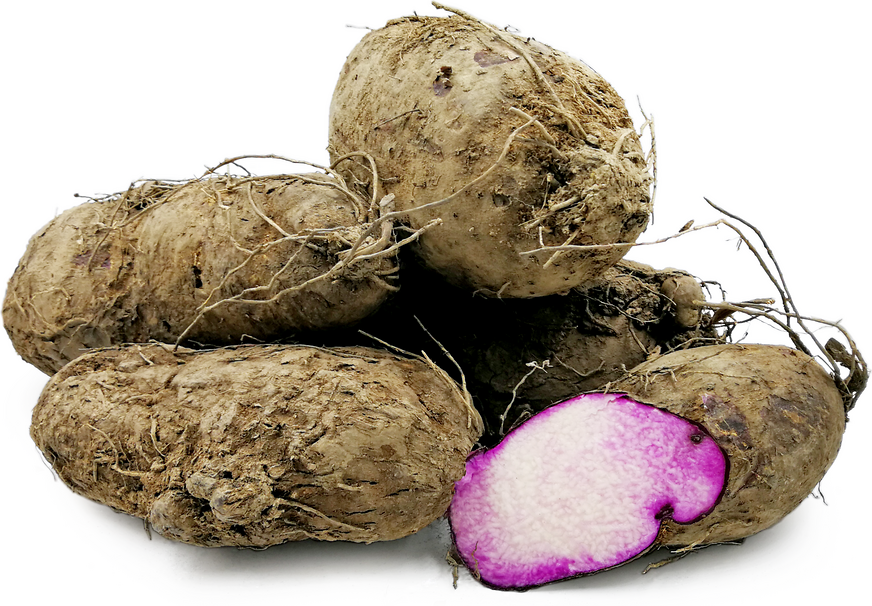


Ubi Badak
Estimated Inventory, lb : 0
Description/Taste
Ubi Badak yams are medium to large in size and are round, ovate, or oblong in shape with some irregular bumps and lumps. The skin is rough, dusty brown to gray, and displays thin, straggly hairs which are the petite roots of the tuber. The flesh is firm, densely textured, and features hues of violet, purple, and creamy white, depending on the variety. The leaves of the Ubi Badak vine are broad to ovate and green, growing opposite one another on non-woody stems with some leaves positioned alternately towards the base of the plant. When cooked, the tuber offers a starchy texture and subtly sweet flavor with nuances of chestnut. Tubers for consumption are typically harvested at the end of their season when about ten centimeters in length. If left on the plant, however, the Ubi Badak tubers will continue to grow year after year and can grow to be as large as one to two meters in length.
Seasons/Availability
Ubi Badak yams are available year-round, with peak season in late summer through late spring.
Current Facts
Ubi Badak yams, botanically classified as Dioscorea alata, are a Malaysian variety and are members of the Dioscoreaceae family, which is predominantly made up of perennial herbaceous vines. Tuber crops such as the Ubi Badak have long been an important yam variety and a food staple in the Malaysian diet. Also known as the Winged yam or Water yam in English, Tai Shu in Hakka, and Mao Shu, Shen Shu or Fake Chinese yam in Mandarin, Ubi Badak yams are a popular ingredient in snacks and desserts, particularly as an ingredient in kuih, which are traditional snacks from Malaysia.
Nutritional Value
Ubi Badak provides an excellent source of dietary fiber, complex carbohydrates, and naturally occurring antioxidants.
Applications
Ubi Badak yams are best suited for cooked applications such as roasting, baking, boiling, and steaming. They are typically peeled before use, but they can also be roasted within their skin on. One of the most popular uses for Ubi Badak is cooked, pureed, and added to desserts, savory snacks, and baked goods. Both pureed and cubed Ubi Badak is also a popular addition to soups and puddings, and it can also be pounded down to make flour. Ubi Badak will keep up to two weeks when stored in a cool, dark place. Refrigeration should be avoided as this will cause them to lose flavor and spoil faster.
Ethnic/Cultural Info
In 2009 the Ubi Badak yam was featured on a Malaysian stamp as part of a collection of stamps featuring the root crops of Malaysia. Ubi Badak is a popular ingredient in some traditional kuih preparations, both sweet and savory such as ondeh-ondeh or round ball-shaped cakes. Kuih’s are a popular snack food in Malaysia and are enjoyed in a fashion similar to that of tapas in Spain.
Geography/History
Ubi Badak yams are thought to have originated several thousand years ago in southeastern Asia, potentially as a result of hybridization. During food shortages in World War II, the Ubi Badak provided a source of sustenance at a time when adequate rice supply was difficult to find in Malaysia and as a result has become a staple food source. It was first introduced to the southeastern United States by Spanish and Portuguese explorers in the 1500s but never became a cultivated crop. Rather it became a wild plant growing in the marshes of Georgia, Florida, and parts of Louisiana and is classified as a noxious weed in the state of Florida. Today Ubi Badak can be found growing in the United States and various parts of tropical and sub-tropical Asia and are available at local markets in Asia.
Recipe Ideas
Recipes that include Ubi Badak. One
| Kari Leafs |
|
Purple Yam Cake |




